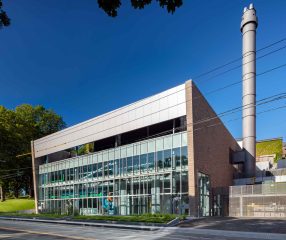Central Energy Plant
To help meet the energy needs of the Medford/Somerville Campus and take a starting step towards decarbonization, the Central Energy Plant (CEP) was constructed in 2018. The CEP replaced the 60-year-old heating plant that had previously provided the campus’s heating and cooling, while all campus electricity was purchased from the electrical grid. The installation of the CEP introduced a more efficient energy system, called cogeneration, which burns fossil fuel to create electricity and uses the heat created during that process to produce heating and cooling.
Watch the video below to see step-by-step how cogeneration works:

The cogeneration system in the CEP does still burn fossil fuel and release emissions, though the increased efficiency compared to traditional power plants means that less emissions are released per unit of fuel and the university saves on energy costs.
While previously the entire campus relied entirely on purchased electricity, about half of campus now receives electricity generated by the CEP. By generating some of our power on-campus, the CEP can continue producing energy in instances where the power grid is down, thus improving the resilience of the Medford/Somerville campus against power outages.
In conjunction with Tufts other renewable energy and energy efficiency initiatives, the CEP is an interim step in the long process of decarbonizing Tufts campuses by 2050.
Want to know more? In 2022, Andrea Woelfel, CEP Operations & Maintenance Planning Manager, and Dariusz Raczkowski, Director of Engineering in Facilities Services, discussed how Tufts identifies and implements energy efficiency projects. Watch the one-hour webinar recording below.